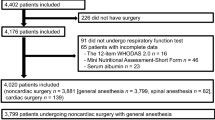Abstract
Purpose
In preoperative settings, patients may have functional disabilities due to the disease for which surgery is being performed or comorbidities, but the associated and predictive factors remain unknown. This study examined the prevalence of preoperative functional disability and clarified the associated factors.
Methods
Individuals aged ≥ 55 years who were scheduled to undergo surgery in a tertiary-care hospital in Japan between April 2016 and September 2016 were eligible for enrolment in the study. Patients with the diseases requiring psychiatric treatment and patients unable to complete the questionnaire without help were excluded. After obtaining informed consent, each patient was asked to complete the 12-item World Health Organization Disability Assessment Schedule-2.0, which is a standardized evaluation tool for assessing comprehensive living function. Data from these questionnaires and the patients’ characteristics were evaluated. Multiple logistic regression analysis was conducted to determine independent factors associated with preoperative functional disability.
Results
Of 1201 recruited patients, 912 (75.9%) were included in our analysis. The prevalence of preoperative functional disability was 29.2%. Regression analysis identified six independent associated factors for preoperative functional disability: body mass index ≥ 30 kg m−2, mixed lung disease, serum albumin values, malnutrition, risk of malnutrition, and preoperative use of corticosteroids.
Conclusions
In total, 29.2% of preoperative patients had functional disability. Obesity, nutritional deficiency, respiratory complications, and low serum albumin values were determined as potentially modifiable factors.


Similar content being viewed by others
References
Abeles A, Kwasnicki RM, Darzi A. Enhanced recovery after surgery: current research insights and future direction. World J Gastrointest Surg. 2017;9:37–45.
Levett DZ, Edwards M, Grocott M, Mythen M. Preparing the patient for surgery to improve outcomes. Best Pract Res Clin Anaesthesiol. 2016;30:145–57.
Ustün TB, Chatterji S, Kostanjsek N, Rehm J, Kennedy C, Epping-Jordan J, Saxena S, von Korff M, Pull C. WHO/NIH Joint Project. Developing the World Health Organization Disability Assessment Schedule 2.0. Bull World Health Organ. 2010;88:815–23.
Soberg HL, Finset A, Roise O, Bautz-Holter E. The trajectory of physical and mental health from injury to 5 years after multiple trauma: a prospective, longitudinal cohort study. Arch Phys Med Rehabil. 2012;93:765–74.
Schiavolin S, Quintas R, Pagani M, Brock S, Acerbi F, Visintini S, Cusin A, Schiariti M, Broggi M, Ferroli P, Leonardi M. Quality of life, disability, well-being, and coping strategies in patients undergoing neurosurgical procedures: preoperative results in an Italian sample. ScientificWorldJournal. 2014;2014:790387.
Measuring Health and Disability: Manual for WHO Disability Assessment Schedule (WHODAS 2.0). Geneva: World Health Organization; 2010. http://apps.who.int/iris/bitstream/10665/43974/1/9789241547598_eng.pdf (accessed 5 Dec 2017).
Shulman MA, Myles PS, Chan MT, McIlroy DR, Wallace S, Ponsford J. Measurement of disability-free survival after surgery. Anesthesiology. 2015;122:524–36.
Ida M, Naito Y, Tanaka Y, Matsunari Y, Inoue S, Kawaguchi M. Feasibility, reliability, and validity of the Japanese version of the 12-item World Health Organization Disability Assessment Schedule-2 in preoperative patients. J Anesth. 2017;31:539–44.
Kaiser MJ, Bauer JM, Ramsch C, Uter W, Guigoz Y, Cederholm T, Thomas DR, Anthony P, Charlton KE, Maggio M, Tsai AC, Grathwohl D, Vellas B, Sieber CC, MNA-International Group. Validation of the Mini Nutritional Assessment short-form (MNA-SF): a practical tool for identification of nutritional status. J Nutr Health Aging. 2009;13:782–8.
Cereda E. Mini nutritional assessment. Curr Opin Clin Nutr Metab Care. 2012;15:29–41.
Melo LC, Silva MA, Calles AC. Obesity and lung function: a systematic review. Einstein (Sao Paulo). 2014;12:120–5.
Launer LJ, Harris T, Rumpel C, Madans J. Body mass index, weight change, and risk of mobility disability in middle-aged and older women. The epidemiologic follow-up study of NHANES I. JAMA. 1994;271:1093–8.
Anderson SD, Bye PT. Exercise testing in the evaluation of diffuse interstitial lung disease. Aust N Z J Med. 1984;14:762–8.
Ginde S, Bartz PJ, Hill GD, Danduran MJ, Biller J, Sowinski J, Tweddell JS, Earing MG. Restrictive lung disease is an independent predictor of exercise intolerance in the adult with congenital heart disease. Congenit Heart Dis. 2013;8:246–54.
Al-Shaiba R, McMillan DC, Angerson WJ. The relationship between hypoalbuminaemia, tumour volume and the systemic inflammatory response in patients with colorectal liver metastases. Br J Cancer. 2004;91:205–7.
McWhirter JP, Pennington CR. Incidence and recognition of malnutrition in hospital. BMJ. 1994;308:945–8.
Ahmed T, Haboubi N. Assessment and management of nutrition in older people and its importance to health. Clin Interv Aging. 2010;5:207–16.
Velázquez Alva Mdel C, Irigoyen Camacho ME, Delgadillo Velázquez J, Lazarevich I. The relationship between sarcopenia, undernutrition, physical mobility and basic activities of daily living in a group of elderly women of Mexico City. Nutr Hosp. 2013;28:514–21.
von Haehling S, Anker SD. Cachexia as major underestimated unmet medical need: facts and numbers. Int J Cardiol. 2012;161:121–3.
Christensen T, Kehlet H. Postoperative fatigue. World J Surg. 1993;17:220–5.
Funding
This work was supported by Nara Prefecture. The grant name is “Nara Medical University Grant-in-Aid for a large-scale prospective cohort study on healthy life expectancy”.
Author information
Authors and Affiliations
Corresponding author
Ethics declarations
Conflict of interest
The authors declare that they have no conflicts of interest.
About this article
Cite this article
Ida, M., Naito, Y., Matsunari, Y. et al. Prevalence and associated factors of preoperative functional disability in elective surgical patients over 55 years old: a prospective cohort study. J Anesth 32, 381–386 (2018). https://doi.org/10.1007/s00540-018-2490-z
Received:
Accepted:
Published:
Issue Date:
DOI: https://doi.org/10.1007/s00540-018-2490-z




